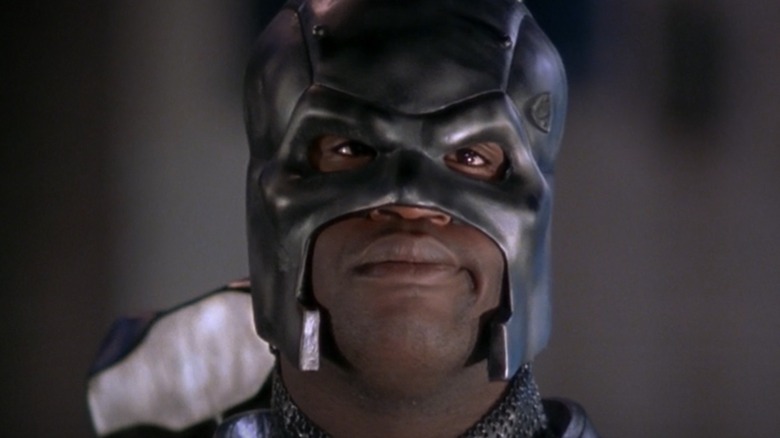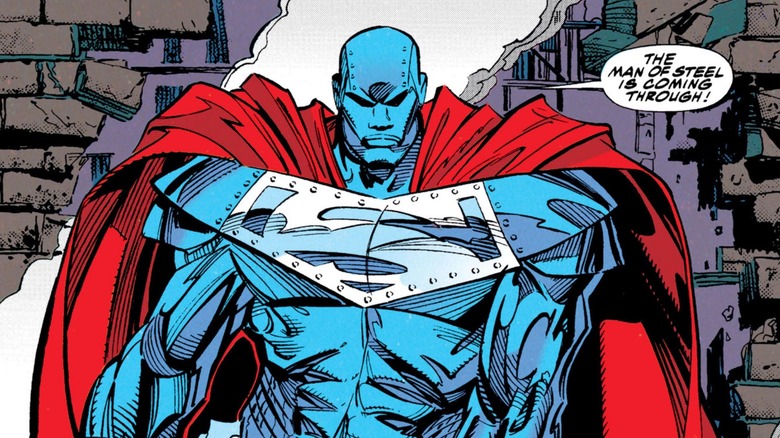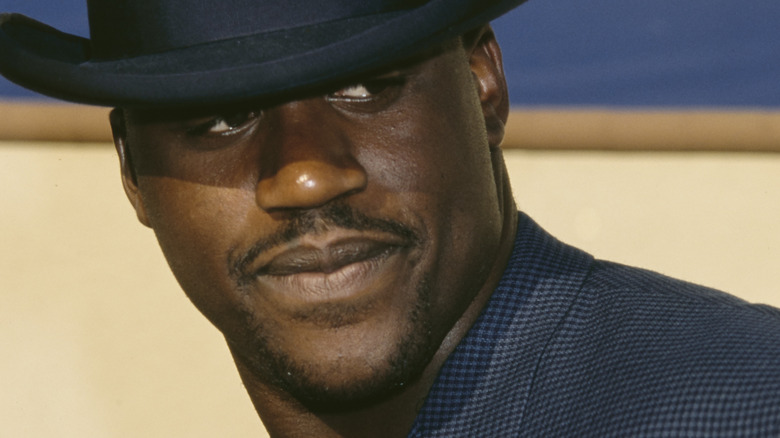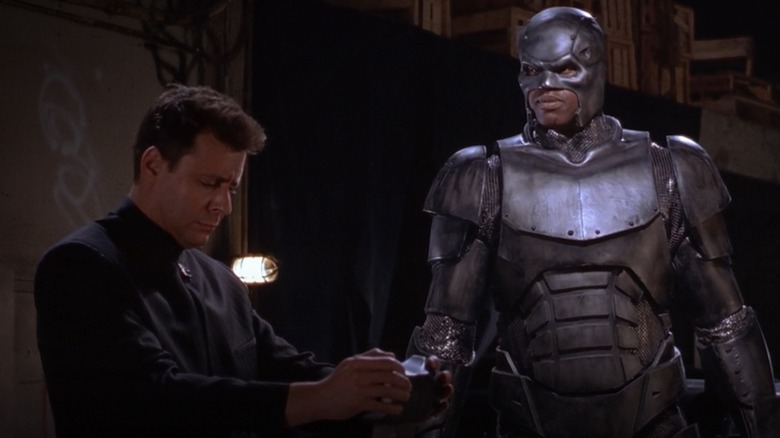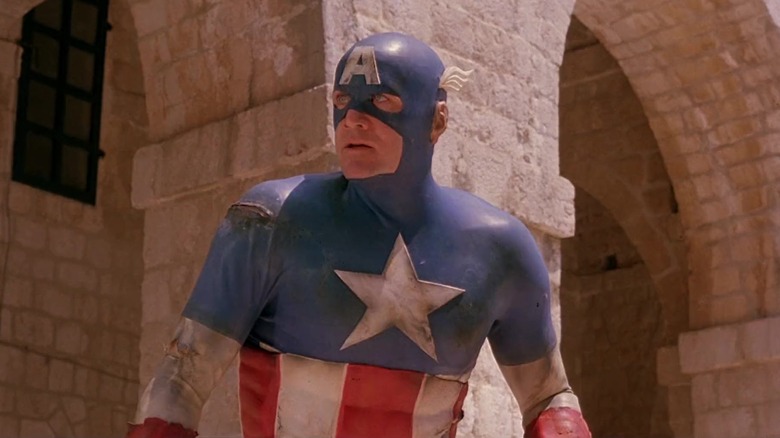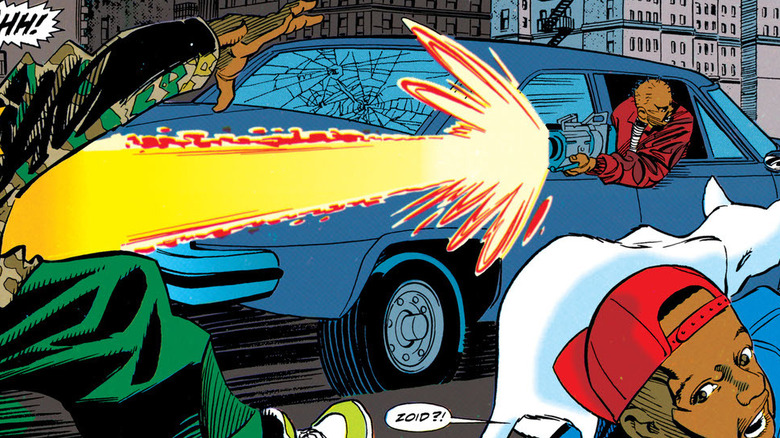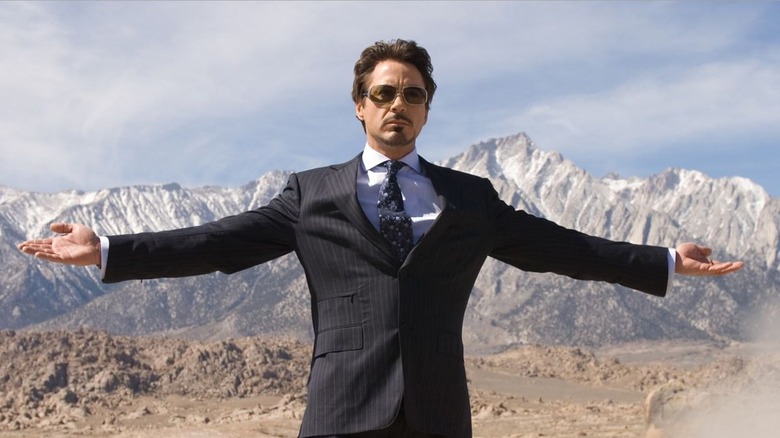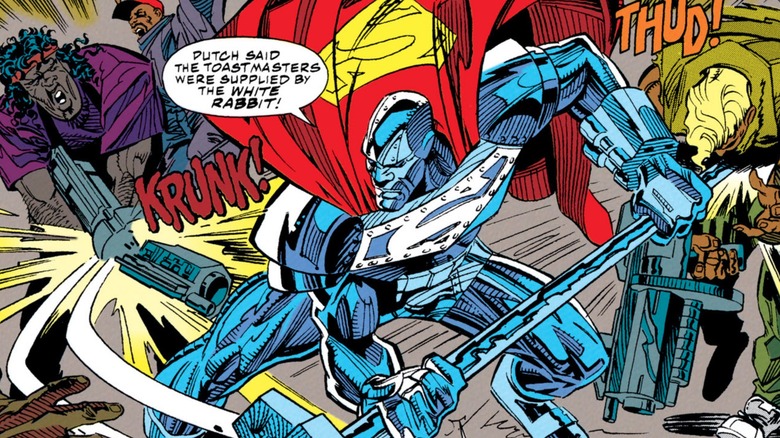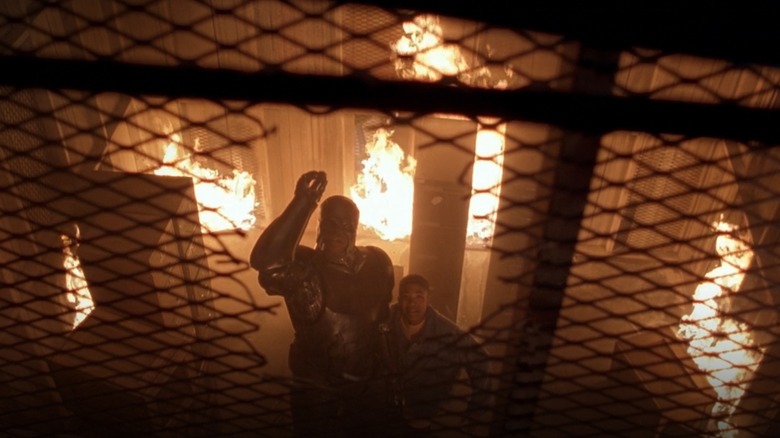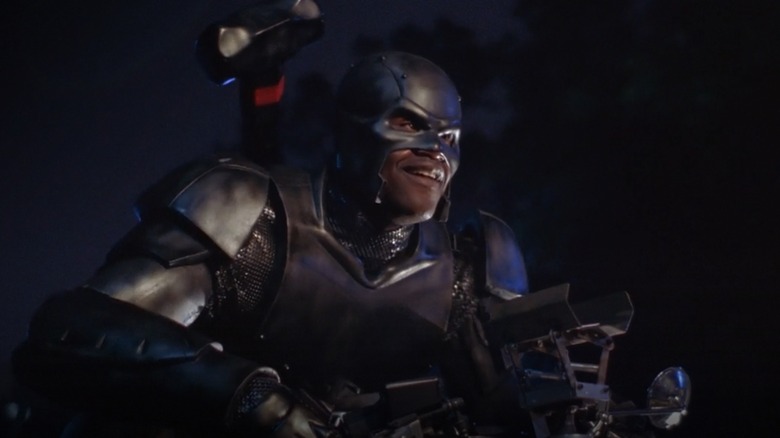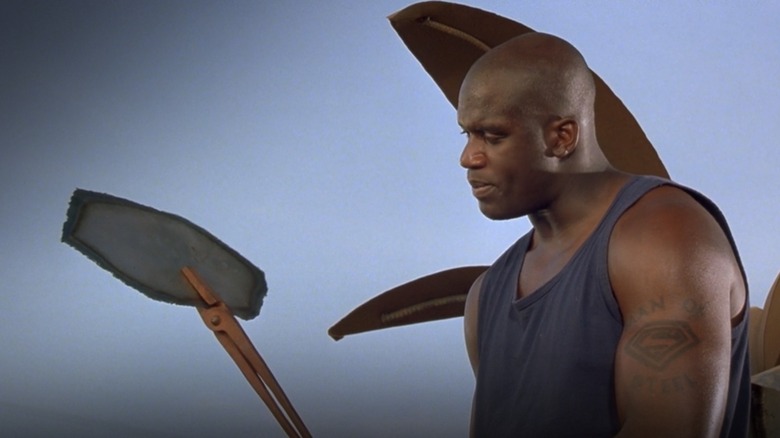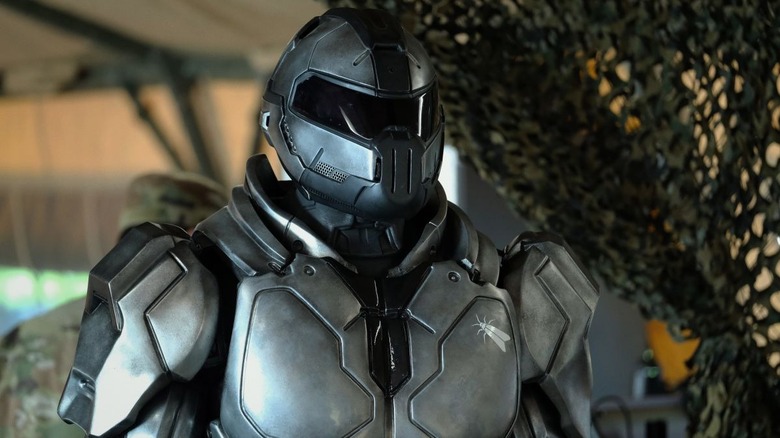The Untold Truth Of Steel
The perception of comic book films has changed quite a bit in the past couple of decades. Right now, four of the top grossing films of all time have roots going back to sequential storytelling. These projects are taken incredibly seriously, with a lot of money and thought put into presenting them to the largest audience possible.
The same can not be said for "Steel," the 1997 flick based on one of Superman's allies starring basketball superstar Shaquille O'Neal. The resulting film, written and directed by Kenny Johnson ("V," "Alien Nation"), is often mentioned when lists of the worst comic films of all time are being compiled. For a time, the only way to watch the film was on a made-to-order DVD through the Warner Archive site, but now you can check it out streaming on HBO Max to see how it stacks up.
In "Steel," Shaq plays John Henry Irons, a weapons designer who quits the military after one of his associates, Nathaniel Burke (Judd Nelson), gets reckless during a demonstration and brings down a building, leading to Steel's partner Sparky (Annabeth Gish) losing the use of her legs. Disgusted with the whole thing, Irons returns to his home in Los Angeles, meets up with his little brother Martin (Ray J), and tries to keep his head down. But it's not long before he discovers that Burke has set up shop nearby and is intent on selling the same weapons. Irons begins working with Sparky and his uncle Joe (Richard Roundtree) to build a high-tech suit of armor he uses to get Burke's guns off the streets.
With more potential eyes on the property in a post-"Justice League" world than when it flopped at the box office, now is the perfect time to uncover the truth of "Steel."
Superman's successor
In the early '90s, DC Comics took a major risk, very publicly killing Superman. He died fighting a nearly unstoppable killing machine called Doomsday, and in the process four very different people arrived to carry on in his wake: Cyborg Superman, Superboy, the Man of Tomorrow, and Steel. Readers first saw them in "Adventures of Superman" #500, but then each one took over one of the four Superman titles at the time with Louise Simonson and Jon Bogdanove shepherding the character in "Superman: The Man of Steel" from #22 through #26 in 1993.
Through those issues, we learn that Steel is actually a man named John Henry Irons who used to make high tech weaponry before the results got too dangerous. He decided to return home to Metropolis and worked in construction. One day his pal fell and, without thinking, he swung out on a chain to save him. He then tumbled himself and Superman swooped in to save him. The hero told Irons to pay it forward by making his life count for something. John was buried in rubble during Superman's fight with Doomsday, but when he got out he decided to follow in his hero's footsteps by crafting an armor, especially after his high tech guns — dubbed Toastmasters — began showing up on the streets. Even after the one true Superman reappeared in the comics, Irons went on to star in his own title, "Steel," which ran for 53 issues between 1994 and 1998. He even joined the Justice League for a time.
Shaq was focused on world domination
During the '90s, there were few stars as big as Shaquille O'Neal — his own website will tell you that. Towering just over seven feet tall, he burst onto the professional basketball scene in 1992, earning the Rookie of the Year honor while playing for the Orlando Magic. Between his affable nature and Hall of Fame-worthy skill, he became a cultural icon. But he had plans to branch out in ways that had not been done before.
In 1993, Shaq released his first of five rap albums, "Shaq Diesel." He followed that up the following year with "Shaq Fu: Da Return" which tied into the similarly titled fighting video game "Shaq Fu." That very same year, he starred in the college basketball drama "Blue Chips," which had him acting alongside Nick Nolte for director William Friedkin. From there, he lead the genie movie "Kazaam" and appeared in "Good Burger" as himself. "Steel" arrived in 1997, coinciding with him not only transitioning from the Orlando Magic to the Los Angeles Lakers, but also playing for the 1996 United States Olympic team, which won a gold medal in Atlanta.
By that point, he hadn't won a championship yet, and some wondered if he might be focusing on too many other arenas. Though he would continue with his music career, O'Neal stopped starring in films at that point, but would pop up in cameos here and there. Going on to play for Miami, Phoenix, Cleveland, and Boston, he would eventually wrap up a nearly 30-year career in 2011.
The director of Steel did not want Shaq to star
Writer-director Kenny Johnson told /Film in 2015 that he liked the idea of making a Black super hero movie. However, he didn't quite believe it when the powers that be first told him that non-actor Shaquille O'Neal was attached to star in the project. He hoped to flesh out the cast with some heavy hitters, but the tight budget would not allow for it.
Johnson and the rest of the crew quickly grew to like the superstar. But time was an issue at this point and the schedule was tight. Shaq was prepping for his debut with the Lakers when the following season opened, and also playing on the second iteration of the U.S. Dream Team, so Johnson arranged for his friend Ben Martin to essentially go to the Athens, Georgia Olympics with O'Neal and train him up for the movie in between practices and games.
After the film came out, Johnson had lunch with Billy Gerber, the former co-president of Warner Bros. who had been fired after the film came out. When the filmmaker asked why the studio insisted on having O'Neal star, the former exec revealed that it was because they thought Shaq would sell more toys than someone like Wesley Snipes, who had been Johnson's first choice.
This was a weird time for comic book movies
There's no two ways about it — Hollywood did not know what to do with comic book movies in the '90s. The results are all over the map, some with shoehorned celebs in lead roles, some being surprisingly good adaptations of comics that most people have never heard of, and, well, a lot of craziness. By the beginning of the decade, all four Christopher Reeve "Superman" films had come and gone. While the first two may have made you believe a man could fly, the final pair proved how hard a franchise could tank. Tim Burton's "Batman" seemed to change the game in 1989, but not every superhero movie the following decade could truly follow suit.
In 1990, both the surprisingly dark "Teenage Mutant Ninja Turtles" and a big-screen attempt at "Captain America" — starring J.D. Salinger's grandson Matt — debuted. "The Rocketeer" took off in 1991, with "Batman Returns" hitting the following year. 1994 offered up an interesting mix that included "The Crow" and "Time Cop." This would have also most likely been the year that the never-released "Fantastic Four" film would have come out. Sylvester Stallone and Pamela Anderson got in on the action with "Judge Dredd" in 1995 and "Barb Wire" in 1996. Meanwhile, the Dark Knight took a major tonal shift in 1995 with "Batman Forever."
By the time "Steel" came out on August 15, 1997, three other comic films had already bowed that year — both "Batman and Robin" and "Men in Black" earlier that summer, and "Spawn" just two weeks prior. Everything changed in 1998 with the release of "Blade," which showed the world that comic book films really could balance big, fun, exciting action with dark, gritty, R-rated adult entertainment. Just a few years later, "Spider-Man" and "X-Men" would continue to further the efforts leading right up to the films we enjoy today.
Surprisingly violent source material
In a 2017 interview with Vice, writer-director Kenny Johnson explained a number of the problems he ran into while making "Steel." One of the early ones, he remembers, was that the comics were surprisingly gory. Though it might come as a surprise, he's not wrong. That aforementioned run of "Superman: Man of Steel" issues starring Irons does in fact feature the Toastmaster weapons obliterating people, leaving smoldering corpses behind. The manufacturing and selling of these illegal weapons was overseen by a woman calling herself the White Rabbit, who had a history with Irons going back to when he designed the guns in the first place.
It might seem that the PG-13 "Steel" film strays pretty drastically from the source material. Johnson explains that he aimed the story at more of a family audience, which makes sense when you compare it to the comics. The movie still explores Irons' guilt over creating weapons, there's still an old associate carrying on that work without his knowledge, and even a semi-love story. Johnson simply streamlined the relationships and split White Rabbit into Burke and Sparky. Aside from those nods to the comics, all Superman references were scrubbed form the story — aside from Shaq's real-life "Man of Steel" tattoo complete with Superman logo on his left arm (per Body Art Guru).
John Henry Irons Man
If the idea of a man who designs weapons leaving that life behind after seeing what those same arms can do before donning a suit of armor sounds familiar, then you've probably also seen the 2008 "Iron Man" film. That first entry in the Marvel Cinematic Universe begins with Tony Stark showing off what his new weapons system can do. He then gets captured by the Ten Rings, who want him to make munitions for them, but instead he builds the first suit of Iron Man armor to break free. The rest is Marvel history, as he goes on to make a variety of different suits throughout the course of the other films in the series.
"Steel" also begins with the main character exhibiting the weapons he's been working on. While the other circumstances are different, John Henry Irons also winds up building a suit with the equipment and technology available to him and Sparky in Uncle Joe's junkyard. Both men have a change of heart when they see what their inventions can do up close. Since the comic character Iron Man debuted much earlier — in 1963's "Tales of Suspense" #39 — he gets the edge as far as originality goes, but it is interesting that these two films which came out a decade apart have such similar set-ups.
The armor is very different
Over the decades, fans have seen all manner of interpretations when it comes to translating two-dimensional costumes drawn on the comics page to a three-dimensional person on the big screen. Christopher Reeve and Michael Keaton wore pretty faithful versions of Superman and Batman, to the delight of fans new and old alike. The same can not be said for O'Neal's Steel, though.
Both the comic and movie suits were forged from molten metal, but the results are quite different. The comic version features the shiniest metal you could imagine, with a full-head helmet, jet boots, nail-firing gauntlets, and a red Superman cape. The film version does feature a body-covering armor, but one with a more matte finish. It also lacks the cape completely and has a helmet with openings for the mouth and eyes. Mostly, though, it doesn't really look like it's made out of metal. As Johnson explained to Vice, this was the result of not having a lot of time, but also the idea that it should look as homemade as possible.
The thing about the free throws
Throughout the film, John Henry Irons struggles to toss anything into objects even remotely resembling a basketball hoop. Trash lands outside the can, and a towel flops squarely on a dog's head instead of its intended bin. Then, by the end, there's a bit where he has to throw a grenade through a small opening to save Martin. These moments were included as a way for O'Neal and the filmmakers to poke fun at his inability to shoot free throws in his day job. As a premiere center, Shaq either dunked the ball or shot from just a few feet away in the paint. The further he got from the basket, the less likely the ball was to go in, especially during free throws. In fact, teams would foul the big man on purpose, thinking that he was far less likely to make the two uncontested shots than to just slam it in. Thus the term "Hack-a-Shaq" was born – it even has its own Wikipedia page.
This inability to shoot from distance did not just play into the film as a running gag, though — it was also something that had to be dealt with during filming. Co-producer Mark Allan told /Film that it was written into the contract that there had to be a hoop near every shooting location for Shaq to work on his shot in between takes, which could lead to a few headaches when the crew needed him for shooting.
A literal shooting location
Though Johnson toned down the violence from the comics, with the film featuring laser and sonic weapons rather than more traditional ordnances, that did not stop the production from experiencing some truly dangerous moments. The crew remembers remember filming a night scene with Steel on his motorcycle that involved a helicopter in the scene and another helicopter filming everything.
Director of Photography Mark Irwin posited to /Film that nearby drug dealers in the neighborhood were put on edge by all of this, and gunshots eventually rang out. He notes that shots were fired at both the filming lights and the helicopter. Of course, everyone scattered in fear, but this proved to be only a one-time event during production.
Steel bombed, but why?
Johnson has said that "Steel" was hindered right from jump, thanks to a lower-than-expected budget, a less-than-seasoned lead, and a tight filming schedule. Even so, he likes the film that he was able to make given those restrictions. So why did the film only make $1.7 million on a $16 million budget (especially after the much-maligned "Batman and Robin" took its $125 million budget and made $238 million worldwide)? It all comes down to advertising, and Shaq's former agent and "Steel" executive producer Leonard Armato told /Film he believes that Warner Bros. did not give the film a bigger advertising budget because it starred an African American lead.
A number of people involved note that the studio did not put resources behind advertising the film. Johnson thinks that part of that came as the result of WB's "Conspiracy Theory" stumbling out of the starting gate, which had megastars Mel Gibson and Julia Roberts headlining. That movie opened earning just shy of $20 million, but went on to take in roughly $137 million worldwide. He also says that the marketing department was fired after "Steel" failed to draw eyes. Whatever the case may be, a fun, very of-the-time flick just did not land with the audience.
More Steel on the horizon?
Even with the film failing at the box office and holding a less-than-beloved status, there is still interest in more "Steel" on the silver screen – at least from Shaquille O'Neal. As PopCulture.com reported in 2021, Shaq has brought up the idea of doing it all over again, this time with modern effects, drawing comparisons to "Iron Man" himself. Of course, DC's slate films has been filled with projects like "Black Adam," the sequels for "Shazam" and "Aquaman," plus "The Flash" solo film, with no word of a Steel project. Beyond that, with the apparent closure of the Snyderverse, the nature of Superman himself is in question when it comes to the big screen. Of course, nothing is entirely beyond the realm of possibility.
The character has shown up on the small screen. Animated versions of Steel have appeared on "Superman: The Animated Series," "Justice League Unlimited," and "Young Justice: Outsiders." The CW's "Superman and Lois" features a very different take on the John Henry Irons character, played by Wolé Parks. This armored man comes from an alternate reality dominated by an evil Superman. After spending time in the show's main continuity, though, he comes to realize that this version of the hero is much different, and they become allies. It's not a bad resume for a character who originally debuted as a Superman fill-in.
